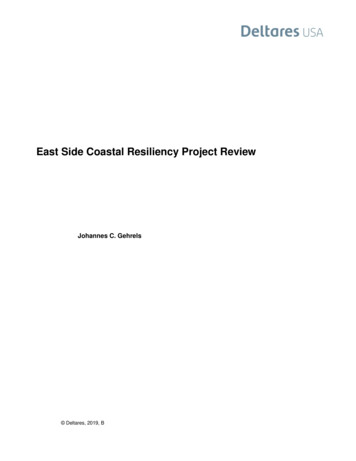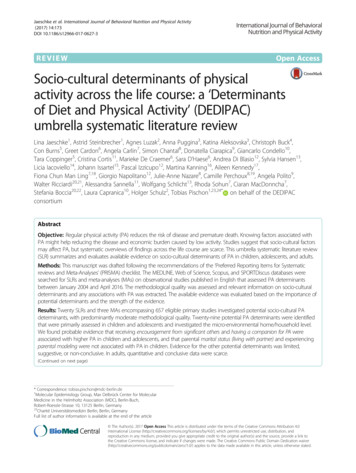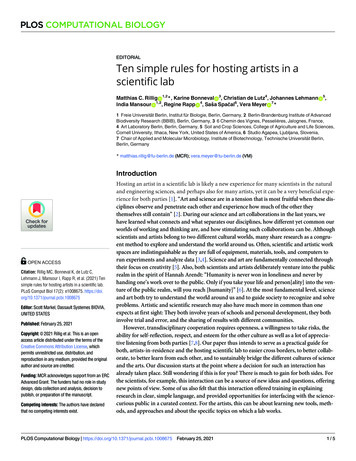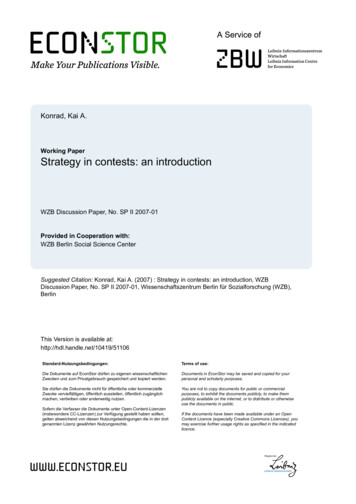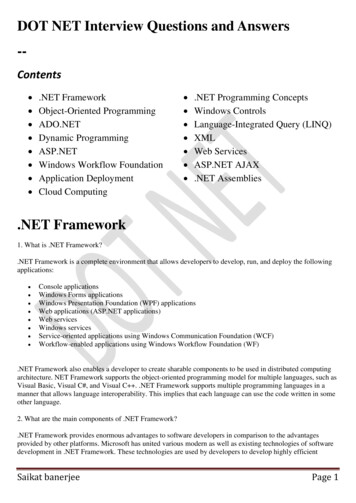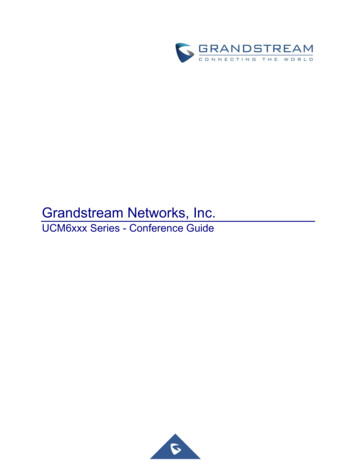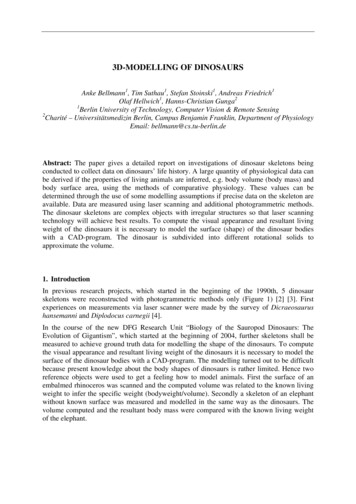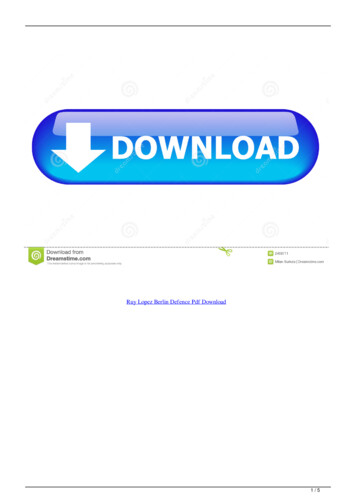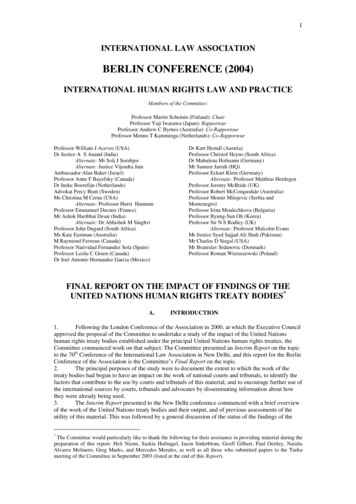
Transcription
1INTERNATIONAL LAW ASSOCIATIONBERLIN CONFERENCE (2004)INTERNATIONAL HUMAN RIGHTS LAW AND PRACTICEMembers of the Committee:Professor Martin Scheinin (Finland): ChairProfessor Yuji Iwasawa (Japan): RapporteurProfessor Andrew C Byrnes (Australia): Co-RapporteurProfessor Menno T Kamminga (Netherlands): Co-RapporteurProfessor William J Aceves (USA)Dr Justice A S Anand (India)Alternate: Mr Soli J SorabjeeAlternate: Justice Vijendra JainAmbassador Alan Baker (Israel)Professor Anne F Bayefsky (Canada)Dr Ineke Boerefijn (Netherlands)Advokat Percy Bratt (Sweden)Ms Christina M Cerna (USA)Alternate: Professor Hurst HannumProfessor Emmanuel Decaux (France)Mr Ashok Haribhai Desai (India)Alternate: Dr Abhishek M SinghviProfessor John Dugard (South Africa)Ms Kate Eastman (Australia)M Raymond Favreau (Canada)Professor Natividad Fernandez Sola (Spain)Professor Leslie C Green (Canada)Dr Joel Antonio Hernandez Garcia (Mexico)Dr Kurt Herndl (Austria)Professor Christof Heyns (South Africa)Dr Mahulena Hofmann (Germany)Mr Sameer Jarrah (HQ)Professor Eckart Klein (Germany)Alternate: Professor Matthias HerdegenProfessor Jeremy McBride (UK)Professor Robert McCorquodale (Australia)Professor Momir Milojevic (Serbia andMontenegro)Professor Irina Moulechkova (Bulgaria)Professor Byung-Sun Oh (Korea)Professor Sir N S Rodley (UK)Alternate: Professor Malcolm EvansMr Justice Syed Sajjad Ali Shah (Pakistan)Mr Charles D Siegal (USA)Mr Branislav Srdanovic (Denmark)Professor Roman Wieruszewski (Poland)FINAL REPORT ON THE IMPACT OF FINDINGS OF THEUNITED NATIONS HUMAN RIGHTS TREATY BODIES*A.INTRODUCTION1.Following the London Conference of the Association in 2000, at which the Executive Councilapproved the proposal of the Committee to undertake a study of the impact of the United Nationshuman rights treaty bodies established under the principal United Nations human rights treaties, theCommittee commenced work on that subject. The Committee presented an Interim Report on the topicto the 70th Conference of the International Law Association in New Delhi, and this report for the BerlinConference of the Association is the Committee’s Final Report on the topic.2.The principal purposes of the study were to document the extent to which the work of thetreaty bodies had begun to have an impact on the work of national courts and tribunals, to identify thefactors that contribute to the use by courts and tribunals of this material, and to encourage further use ofthe international sources by courts, tribunals and advocates by disseminating information about howthey were already being used.3.The Interim Report presented to the New Delhi conference commenced with a brief overviewof the work of the United Nations treaty bodies and their output, and of previous assessments of theutility of this material. This was followed by a general discussion of the status of the findings of the*The Committee would particularly like to thank the following for their assistance in providing material during thepreparation of this report: Heli Niemi, Saskia Hufnagel, Jason Söderblom, Geoff Gilbert, Paul Oertley, NataliaAlvarez Molinero, Greg Marks, and Mercedes Morales, as well as all those who submitted papers to the Turkumeeting of the Committee in September 2003 (listed at the end of this Report).
2treaty bodies under international law, the views taken by domestic courts of their status and usefulness,and an exploration of some of the factors that are conducive to the use of these and other internationalmaterials by national courts and tribunals. The longest section of the report followed, comprising thedocumentation of a large number of cases in which national courts and tribunals had referred tofindings of the UN human rights treaty bodies. The Interim Report offered some preliminaryconclusions, and suggested a plan of action for the second stage of the project.4.The New Delhi meeting of the Committee welcomed the Interim Report and decided that theFinal Report should, so far as possible, include:(a) more examples of the use of treaty body output by national courts and tribunals, both from thosejurisdictions already represented but also and equally importantly from jurisdictions/languagegroups which had not been well-represented in the materials covered by the Interim Report;(b) an examination of the use of treaty body output by international courts and tribunals;(c) illustrative examples of the use of treaty body output at the national level by bodies other thancourts and tribunals (e.g. law reform commissions, human rights commission, Ombudsprocedures);(d) a more detailed analysis of the impact and use of treaty body output, in particular legal aspects ofthe use of these materials, and the circumstances which lead to an increased use of them; and(e) consideration of recommendations and future action in relation to the development and use ofthese materials.Meeting in Turku5.Since the New Delhi conference, the Committee has met on one occasion. The meeting washeld in Turku, Finland, from 26-27 September 2003, and was organised by the Institute for HumanRights, Åbo Akademi University, with considerable financial assistance from the Government ofFinland. The Committee gratefully acknowledges the support of the Institute for Human Rights and theGovernment of Finland in making this very constructive meeting possible. The purpose of the meetingin Turku was to review the progress of the Committee’s work and to provide the opportunity forcontributions by members of the Committee and others relevant experts to contribute to the preparationof the 2004 report of the Committee. Many members of the Committee were able to attend, and someof those who were not able to make written contributions that were considered at the meeting. Anumber of other experts in the field and representatives of the Office of the UN High Commissioner forHuman Rights also attended the meeting or made written contributions, for which the Committeewould like to express its appreciation.16.The Turku meeting considered the Interim report of the Committee and the recommendationsof the New Delhi meeting, as well as the written and other presentations made in Turku. As a result ofthe discussions, the meeting made a number of recommendations about the structure and content of theFinal Report. The principal recommendations were that the Final Report should, if possible, includesections on:(a) The use of treaty body output by international courts and tribunals;(b) The use of treaty body output by national bodies other than courts and tribunals;(c) How the treaty body output fits into the traditional approaches to and sources for theinterpretation of treaties;(d) Factors conducive to the increased use of treaty body output at the national level (includingthe manner in which the output itself is generated);(e) Implementation of treaty body output in individual cases (including the relationship of caselaw to individual legal systems);1A list of the written papers presented to the meeting appears at the end of this report. Most of these papers, aswell as further material supplied after the meeting, are available through the website of the Institute for HumanRights: www.abo.fi/instut/imr (under Seminars).
3(f) Appropriate recommendations to promote the increased use of treaty body output byinternational and national bodies; and(g) How the collection and dissemination of information about the use of treaty body output couldbe continued in a coordinated manner after the conclusion of this project, and whether suitablepartners could be identified for this purpose.7.This structure and content of this Final Report has been developed in response to the decisionsand recommendations of the New Delhi and Turku meetings.2B.THE STATUS OF HUMAN RIGHTS TREATY BODY FINDINGSReference to the status of general comments/recommendations and decisions of the committeesand their value as an interpretive guide8.The Interim Report contained many references to statements made by domestic courts aboutthe relevance and utility of treaty body findings (in particular decisions in individual cases, and generalcomments or recommendations), as well as to discussions of the status of particular treaty bodies(especially when compared with international and domestic courts). In general, courts have noted that,while the treaty bodies are not courts, their findings are relevant and useful in some contexts.However, they have usually stopped short of concluding that they are obliged to follow treaty bodyinterpretations, even in cases in which the treaty body has expressed a view on a specific case or lawfrom the jurisdiction in question.9.Some further examples may be added to those in the earlier report. For example, theConstitutional Court of Spain has considered the status of the Human Rights Committee and its viewsin response to cases in which the Committee has found violations of the ICCPR by Spain.3 In one casein which it considered a finding by the Human Rights Committee4 that the procedures under Spanishlaw for review of criminal convictions fell short of the guarantee of an appeal contained in article 14(5)of the ICCPR, the Court noted that the Committee was not a court and that its views did not constitute abinding interpretation of the ICCPR.510.In Kavanagh v Governor of Mountjoy Prison,6 Fennelly J, delivering the judgment of thecourt, commented in relation to the argument that the views of the Human Rights Committee could begiven effect to directly under Irish law, notwithstanding article 34(1) of the Irish Constitution:7“The notion that the ‘views’ of a Committee even of admittedly distinguished experts oninternational human rights experts, though not necessarily lawyers, could prevail against theconcluded decision of a properly constituted court is patently unacceptable. To be fair, even ininternational law, neither the Covenant nor the Protocol make[s] such a claim. Neither theCovenant nor the Protocol at any point purports to give any binding effect to the viewsexpressed by the Committee. The Committee does not formulate any form of judgment ordeclare any entitlement to relief. Its status in international law is not, of course, a matter forthis court. It suffices to say that the appellant has not furnished any arguable case for the effectof the Committee's views.”11.In the South African case, Residents of Bon Vista Mansions v Southern Metropolitan LocalCouncil8 the High Court stated that “General Comments have authoritative status under internationallaw” and continued by quoting General Comment No 12 of the Committee on Economic, Social andCultural Rights in explaining the duty to respect “rights of access”.9 Budlender AJ also made it clear2For reasons of space, it was not possible to provide a consolidated table of all the cases referred to in the Interimand Final Reports.3Discussed in more detail below.4Gómez Vásquez v Spain, Communication No 701/1996, UN Doc CCPR/C/69/D/701/1996 (11 August 2000)5STC 70/2002, 3 April 2002, para 7.6[2002] IESC 11 (1 March 2002)(Supreme Court of Ireland)7Article 34, section 1 of the Constitution of Ireland provides:"Justice shall be administered in courts established by law by judges appointed in the manner providedby this Constitution, and, save in such special and limited cases as may be prescribed by law, shall beadministered in public."8(2002) 6 BCLR 625 (High Court Witwatersrand, Local Division).9Id at 629, paras 17-18.
4that he relied upon international law to interpret the Bill of Rights “where the Constitution useslanguage similar to that which has been used in international instruments”.1012.The Full Court of the Federal Court of Australia has recently commented on theappropriateness of referring to treaty body views:11"Although the views of the [Human Rights] Committee lack precedential authority in anAustralian court, it is legitimate to have regard to them as the opinions of an expert bodyestablished by the treaty to further its objects by performing functions that include reporting,receiving reports, conciliating and considering claims that a State Party is not fulfilling itsobligations. The Committee's functions under the Optional Protocol to the InternationalCovenant on Civil and Political Rights, to which Australia has acceded (effective as of 25December 1991) are particularly relevant in this respect. They include receiving, consideringand expressing a view about claims by individuals that a State Party to the Protocol hasviolated covenanted rights. The conclusion that it is appropriate for a court to have regard tothe views of such a body concerning the construction of a treaty is also supported by theobservations of Kirby J in Johnson v Johnson (2000) 201 CLR 488 at 501-502, and of Katz Jin Commonwealth v Hamilton (2000) 108 FCR 378 at 387, citing some observations of BlackCJ in Commonwealth v Bradley (1999) 95 FCR 218 at 237. See also The Queen v Sin YauMing [1992] 1 HKCLR 127 at 141. It is appropriate, as well, to have regard to the opinionsexpressed in works of scholarship in the field of international law, including opinions basedupon the jurisprudence developed within international bodies, such as the Committee."13.Finally, a bill of rights adopted in the Australian Capital Territory in 2004, which expresslygives effect to provisions of the ICCPR, provides that “international law, and the judgments ofinternational and foreign courts and tribunals, relevant to a human rights may be considered ininterpreting the human right.”12 “International law” is defined as including “general comments andviews of the United Nations human rights treaty monitoring bodies.”13Constitutional interpretation by reference to international human rights standards14.In the South African case of Bon Vista Mansions14 Budlender AJ made it clear that he reliedupon international law to interpret the Bill of Rights “where the Constitution uses language similar tothat which has been used in international instruments”.15 Justice Kirby of the High Court of Australiahas on a number of occasions stated that in his view it is appropriate to look to international humanrights standards in constitutional interpretation, including the jurisprudence of the United Nationshuman rights treaty bodies.1610Id at 629, para 15. Article 39(1)(b) of the Constitution of the Republic of South Africa 1996 provides: “Wheninterpreting the Bill of Rights, a court, tribunal or forum . . . (b) must consider international law”.11Minister for Immigration & Multicultural & Indigenous Affairs v Al Masri [2003] FCAFC 70, at para 148 (15April 2003), 70.html. The case is on appeal to the High Courtof Australia. See also Kirby J in Minister for Immigration and Multicultural and Indigenous Affairs v B [2004]HCA 20, at paras 147-155.12Human Rights Act 2004 (ACT), s 3113Human Rights Act 2004 (ACT), Dictionary (definition of “international law”, para (b))14Residents of Bon Vista Mansions v Southern Metropolitan Local Council (2002) 6 BCLR 625 (High CourtWitwatersrand, Local Division).1516Id at 629, para 15.Recent examples are Austin v Commonwealth of Australia [2003] HCA 3, at para 252 n 335 (referring toKarttunen v Finland, Human Rights Committee, 23 October 1992); Attorney General (WA) v Marquet [2003]HCA 67, paras 173-180 (referring to General comment No 25; concluding observations on Hong Kong, Paraguay,and Chile; and Landinelli Silva v Uruguay (Communication No 34/78), and Pietraroia v Uruguay(Communication No 44/79)). However, some other members of the Court do not share this view. See, for example,the views of Callinan J in Western Australia v Ward (2002) 191 ALR 1, noted in (2003) 23 Australian Yearbook ofInternational Law 234.
5THE STATUS OF TREATY BODY FINDINGS15.The question of the status of treaty body findings as binding rulings on the provisions of thetreaties was discussed in the Interim report.17 It seems to be well accepted that the findings of the treatybodies do not themselves constitute binding interpretations of the treaties.18 The Human RightsCommittee and the Committee against Torture have emphasised -- particularly in the context of theindividual complaints procedures (and requests for interim measures) – that the legal norms on whichthe treaty bodies pronounce are binding obligations of the States parties, and therefore thepronouncements of the treaty bodies are more than mere recommendations that can be readilydisregarded because a State Party disagrees with the interpretation adopted by the Committee or withits application to the facts.16.Governments have tended to stress that, while the views, concluding observations andcomments, and general comments and recommendations of the treaty bodies are to be accordedconsiderable importance as the pronouncement of body expert in the issues covered by the treaty, theyare not in themselves formally binding interpretations of the treaty.19 While States will give themcareful consideration, they may not give effect to them as a matter of course. Even so, the actions ofStates do not always seem consistent with their rhetoric, as States on occasion take issue with thedecisions of treaty bodies applicable to themselves and contest the findings either as questions of law oron the application of the law to the facts.20 This reluctance is particularly true of executive responses,but is also seen in the responses of some courts to decisions in which the treaty bodies disagree directlywith them or find aspects of the domestic legal system inconsistent with the treaty concerned.17.A more difficult question is where treaty body findings fit into the traditional sources ofinternational law, whether for the purposes of treaty interpretation or as a source relevant to thedevelopment of customary international law.18.None of the human rights treaties explicitly confers on the relevant treaty bodies the power toadopt binding interpretations of the treaties, and the practice of at least some States suggest that thispower has not been conferred implicitly, as part of the implied power that a body established by treatyis considered to possess in order to carry out the functions conferred on it by the States parties. At thesame time, it can be accepted that the treaty bodies have, as a practical matter, the power to adoptinterpretations of the treaty in question, since that is essential to their carrying out their functions.19.Notwithstanding this general statement, the question arises as to whether the findings of aCommittee nevertheless may be viewed as a legitimate (or even persuasive or binding) source forinterpreting the treaty, both as a matter of principle and in relation to particular findings or types offindings.20.It has, for example, been suggested that treaty body findings may constitute, or may generate,“subsequent practice in the application of the treaty which establishes the agreement of the partiesregarding its interpretation”, which article 31(3) of the Vienna Convention of the Law of Treaties(VCLT) provides is to be taken into account in the interpretation of the treaty. It has also beensuggested that treaty body findings may also be taken into account in interpretation as a17See also J S Davidson, "Intention and Effect: The Legal Status of the Final Views of the Human RightsCommittee" [2001] New Zealand Law Review 125.18See Christian Tomuschat, Human Rights: Between Idealism and Realism (2003) 812-813.19For example, the Norwegian Foreign Affairs Ministry has commented:“While the recommendations and criticism of the monitoring committees are not legally binding, theNorwegian authorities attach great importance to them and they constitute important guidelines in thecontinuous efforts to ensure the conscientious implementation of the human rights conventions.”(Norwegian Ministry of Foreign Affairs, Report No 21 to the Storting (1999-2000): Focus on 859/032001-040007/index-hov004-b-n-a.html.)“The treaty bodies also have other tasks besides the processing of reports as described above. They havebeen mandated to produce so-called general comments on the interpretation of particular provisions ofthe conventions. These comments are not legally binding but are of great significance when interpretingthe conventions, and may contribute to the development of customary international law.”(Ibid, bl/p10001859/032001-040007/index-hov005-b-f-See Tomsuchat, supra note 18, at 183.
6“supplementary means of interpretation”21 within the meaning of article 32 of the VCLT, 22 thoughpresumably use of the treaty bodies’ output would have to satisfy the other requirements of article 32.2321.If one adopts a traditional approach to interpretation of the human rights treaties - an approachstrongly endorsed by the International Law Commission and some States parties in the specific contextof reservations -- the findings of the committees themselves would not amount to State practice (or“practice” for the purposes of article 31, if that is a different concept24). However, the responses ofindividual States or of the States parties as a whole to the findings of the committees would constitutesuch practice. Accordingly, in any given case, a positive or supportive response by a State or group ofStates, or the acquiescence of States in a finding by a committee might constitute “subsequent practice . . which establishes the agreement of the parties regarding its interpretation”.22.In this context the question arises of the relationship between the specific provisions of theVCLT and the norms of customary international law relating to treaty interpretation that are reflected inthose provisions. While it is clear that similar or identical norms can be contained in a treaty as well asembodied in rules of customary international law, it does not follow that the overlap in this case mustbe seen as total. The reference in article 31 to subsequent practice – as with so many other provisions inthe VCLT – is written as if no monitoring body had been established by a treaty, as if no third-partyinterests existed, and as if it were only for other States to monitor each other’s compliance and to reactto non-compliance. Human rights treaties are different in some important respects from the presumedideal type of a multilateral treaty which underpins the formulation of the individual provisions of theVCLT.25 Given these differences, it appears arguable that in interpreting these types of treaties (withthird-party beneficiaries and an independent monitoring mechanism), relevant subsequent practicemight be broader than subsequent State practice and include the considered views of the treaty bodiesadopted in the performance of the functions conferred on them by the States parties.23.For example, the general comments and general recommendations of the treaty bodies arecirculated to all States parties following their adoption, generally in the form of the annual report of thecommittee concerned to the General Assembly or to the Economic and Social Council. States have theopportunity to express their views on the correctness of the interpretations at that stage, as well as intheir reports under the treaty and in their discussions with the committees during the consideration ofthose reports. Some States parties have occasionally expressed their disagreement with generalcomments adopted by the Human Rights Committee, for example the General comment relating to theright to life on the possession of nuclear weapons, and its General comment on reservations.26 There21“Subsequent practice which does not fall within [the] narrow definition [of Article 31 (3) (b)] may nonethelessconstitute a supplementary means of interpretation within the meaning of Article 32 of the Convention”. IanSinclair, The Vienna Convention on the Law of Treaties (2nd ed 1984) 138.22The Osaka High Court has expressed the view that general comments and other output of the committees can beconsidered as “supplementary means of interpretation”, Osaka High Court, Judgment of 28 October 1994, 1513HANREI JIHO 71, 87, 38 JAPANESE ANN. INT'L L. 118 (1995). The Court reiterated this view in its Judgment of 28June 1996, not yet reported.23"Article [32] does not provide for alternative, autonomous, means of interpretation but only for means to aid aninterpretation governed by the principles contained in Article [31]". [1966] II YB INT’L L COMM’N 223. "Cetarticle ne donne pas d'énumération exhaustive de ces moyens; il en mentionne les plus importants, les travauxpréparatoires et les circonstances dans lesquelles le traité a été conclu." Mustafa Kamil Yasseen, "L'interprétationdes traités d'après la Convention de Vienne sur le droit des traités”, (1976) 151 RCADI 1, 79.24Compare the comment by the WTO Appellate Body in Japan – Alcoholic Beverages Case: “We do not agreewith the Panel’s conclusion that ‘panel reports adopted by the GATT Contracting Parties and the WTO DisputeSettlement Body constitute subsequent practice in a specific case’ as the phrase ‘subsequent practice’ is used inArticle 31 of the Vienna Convention.” However, Herdegen argues that the practice of organs such as the treatybodies can be seen as falling within article 31(3): "Inasmuch as the States parties have entrusted to these organs[the European Court of Human Rights, the Human Rights Committee, the UN Security Council, and WTO panels]the competence to adjudicate on disputes within the framework of their respective treaties or to progressively givedetailed content to treaty provisions which require interpretation, the practice of these bodies can be seen astantamount to subsequent practice of the parties to the treaty which establishes the agreement of the partiesregarding its interpretation" Matthias Herdegen, Völkerrecht (3rd ed 2004), 125 (translation by Andrew Byrnes).See also Robert McCorquodale, “An Inclusive International Legal System” (2004) Leiden Journal of InternationalLaw (forthcoming).25See, for example, Theodor Meron, The Implications of the European Convention on Human Rights for theDevelopment of Public International Law (2000), report prepared for the Ad Hoc Committee of Legal Advisers onPublic International Law (CAHDI) of the Council of Europe, at 4-6.26See Tomuschat, supra note 18, at 156-157.
7appear to have been few similar responses to other general comments and recommendations, so onecould argue that the acquiescence of States parties in those statements could be seen as establishing theagreement of the parties on the interpretation of those provisions. Indeed, States frequently refer to caselaw and general comments or recommendations in their submissions to treaty bodies under the variousindividual complaint procedures, and some have also done so in other fora (such as the InternationalCourt of Justice27), examples which in most cases show acceptance of those materials. In addition,States parties are asked by committees to report on specific matters identified in general comments andrecommendations and to reply to such issues in lists of issues sent to them by committees, and theygenerally do so (or at least do not take exception to such requests by committees).24.In this context, the pronouncements by courts and their application of treaty bodyinterpretations are also relevant, if it is accepted that national court decisions are relevant practice forthe purpose of article 31. If courts consistently accept or follow the interpretation pronounced by atreaty body, then this would be relevant to the question of the agreement of the parties. This analysismight be complicated by the need to analyse in more detail the circumstances of particular cases, aswell as the attitude of the executive government of the State in question.25.So far as decisions and views in individual cases are concerned, once again the issue of whatis relevant State practice arises. The response of the State directly concerned is obviously of importance(though whether one State by its dissent would suffice to delegitimate a decision as a correctinterpretation of the treaty is unclear28). Other States may also respond to these decisions in variousways that are relevant, for example, by referring to these decisions in their own pleadings before acommittee, in their reports to the committee, in the judicial decisions of their courts, or in the form ofdemarches calling on another State to implement or respect a committee's views.26.A similar analysis might be applied to the concluding observations or concluding comments ofthe committees. In the first instance, the response of the State party concerned (and the organs of theState, including the courts and legislature) would be relevant, but other States also use this form ofoutput in other contexts (for example, a number of cases refer to concluding observations in assessingwhether a refugee claim has been made out).27.If this analysis is preferred, then the consequence is that in any given case the status of aparticular general comment or recommendation or decision, or other findings would depend on theresults of a detailed analysis of how States parties has responded to that output in the various waysreferred to above.C.USE OF TREATY BODY FINDINGS BY NATIONAL COURTSGeneral28.This section of the Final report continues the work of documentation of the use of treaty bodyfindings that formed a central part of the Interim report. In addition to noting new cases fromjurisdictions referred to in the Interim report, the Committee has attempted to address one limitation ofthat report by endeavouring to obtain information about other cases in other jurisdictions in whichtreaty body findings have been referred to. While this has involved the examination of the practice inmany additional countries (including, in particular, the countries of Eastern Europe and SouthernAfrica), the harvest has be
Committee commenced work on that subject. The Committee presented an Interim Report on the topic to the 70th Conference of the International Law Association in New Delhi, and this report for the Berlin Conference of the Association is the Committee's Final Report on the topic. 2.
